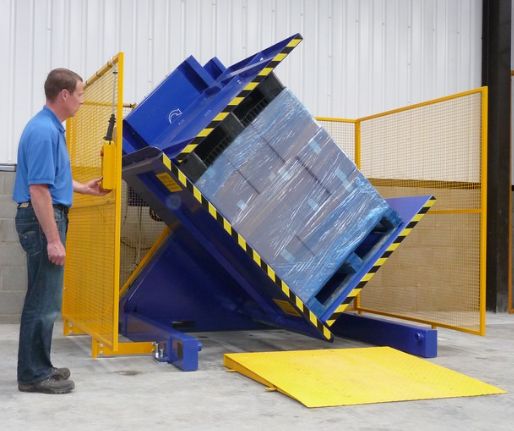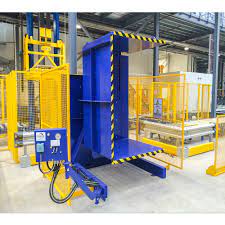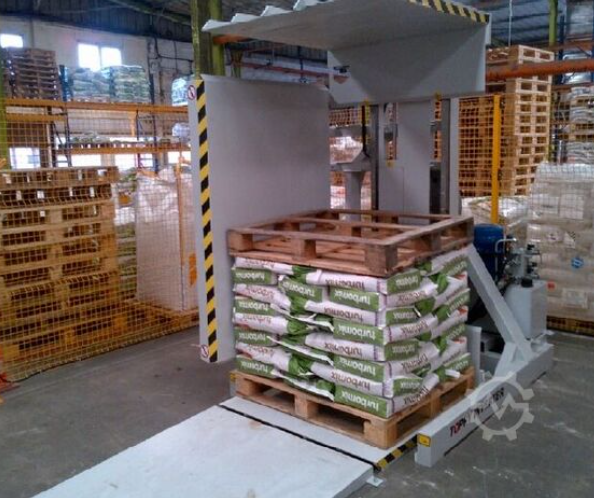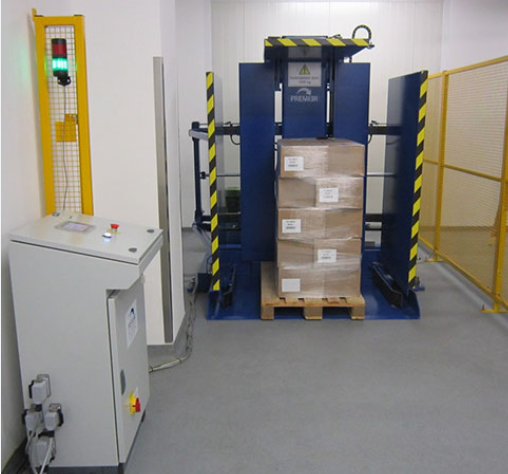Top Reasons Greece Industries Choose Pallet Inverters for Safe Transfer of Unstable Loads in Coastal Factories
Handling unstable loads is a constant challenge in any factory. In the unique coastal environments of Greece, this problem gets worse. The humid, salty air can weaken pallets, and the risk of accidents with valuable, unstable goods is a constant worry for plant managers. Imagine a perfectly good shipment being damaged just before it leaves your factory, or worse, a worker getting injured during a pallet transfer. These are costly problems that disrupt your entire operation. But what if you could eliminate this risk with one smart, robust machine? A pallet inverter is the solution that provides a safe, efficient, and reliable way to handle these challenging loads.
Industries in Greece choose pallet inverters for several key reasons. These machines are essential for improving worker safety when handling heavy or unstable products. They protect goods from damage during pallet exchange, which is critical in corrosive coastal air. Pallet inverters also boost logistical speed and help factories meet strict international shipping and environmental standards. They are a direct solution for maintaining product quality and operational efficiency.

These might sound like big claims for a single piece of equipment. You might be wondering how one machine can impact safety, efficiency, and compliance all at once. It's a fair question. The value of a pallet inverter is not just in its ability to turn a load upside down. The real value is in how it solves specific, costly problems that factories like yours face every day. Let's break down these challenges one by one and see how a pallet inverter offers a practical and powerful solution.
How Do Pallet Inverters Mitigate the Risks of Coastal Humidity and Corrosion?
The air in coastal regions like Greece is full of moisture and salt. This combination is very aggressive. It attacks wooden pallets, causing them to become damp, weak, and even grow mold. Using a compromised pallet to hold a heavy or unstable load is a serious risk. The pallet could fail at any moment. This can damage your product and even lead to contamination. Think about your finished goods sitting on a damp, salt-infused pallet. This can cause rust and other damage, leading to customer complaints and financial losses. The problem isn't your product; it's the pallet underneath it. A pallet inverter gives you a simple way to solve this. It allows you to quickly and safely switch your goods from a standard wooden pallet to a durable plastic or galvanized steel pallet, protecting your products from these environmental risks.
A pallet inverter helps reduce the risks of humidity and corrosion in coastal areas. It does this by letting you move goods from wet, weak wooden pallets to strong, dry plastic or metal ones. This simple switch stops moisture from reaching your products. It also prevents mold from growing and protects valuable goods from damage caused by salt and water. This process is fast, safe, and secures your product's quality.

A Deeper Look at Material Protection
The corrosive environment of a coastal factory presents two primary problems that a pallet inverter directly solves: pallet degradation and product contamination.
The Challenge of Pallet Degradation
Standard wooden pallets act like sponges in humid air. They absorb moisture, which weakens their structure. In coastal areas, the air also carries salt, which gets into the wood and breaks down its fibers even faster. This process, known as chemical and mechanical degradation, significantly reduces the load-bearing capacity of the pallet. A pallet that was safe in a dry environment can become a major safety hazard in a coastal one. The risk of a sudden collapse during transport or storage is very real.
I remember a client in the steel wire industry who was facing constant complaints about surface rust on their shipped coils. We investigated and found the problem was not their manufacturing process. The rust was starting on their products while they were stored in the port-side warehouse. The wooden pallets were absorbing moisture from the air and transferring it directly to the steel coils. After we installed a pallet inverter to switch the coils to galvanized steel pallets right before shipping, their customer complaints about rust dropped to zero. The solution was simple, but it required the right tool.
The Threat of Product Contamination
A damp wooden pallet is not just weak; it's also a breeding ground for mold and bacteria. This is a critical issue for industries like food and pharmaceuticals, but it also affects industrial goods. Mold can stain packaging, and rust can contaminate finished metal products. A pallet inverter allows you to implement a "clean pallet" policy. You can use standard wooden pallets for internal movement and then switch to clean, sanitized plastic or metal pallets for final storage or shipping.
Here is a simple comparison:
| Feature | Standard Wooden Pallet (Coastal) | Plastic / Galvanized Pallet |
|---|---|---|
| Moisture Resistance | Poor - Absorbs moisture and salt | Excellent - Non-porous surface |
| Durability | Low - Degrades quickly | High - Long lifespan, resistant to impact |
| Hygiene | Poor - Prone to mold and bacteria | Excellent - Easy to clean and sanitize |
| Structural Integrity | Decreases over time | Remains consistent |
By using a pallet inverter to manage your pallet choices, you take control of these variables. You ensure that the foundation holding your product is as high-quality as the product itself.
Can Pallet Inverters Really Improve Safety with Unstable and Heavy Loads?
Trying to move heavy and unstable loads by hand is extremely dangerous. Think about stacks of sacks, drums, or boxes that are not perfectly balanced. The risk of the load shifting, falling, and injuring a worker is very high. A single mistake can lead to a serious accident. A worker could suffer a back injury from lifting, or worse, be crushed by a falling load. This is a constant fear for any factory manager, as the human and financial costs of an accident are enormous. A pallet inverter takes the danger out of this process. It uses powerful and precise hydraulics to clamp the load securely. Then, it rotates the entire stack gently and with full control. This eliminates the need for risky manual handling and ensures a safe, stable transfer every time.
Yes, pallet inverters make handling unstable and heavy loads much safer. They do this by mechanizing the entire transfer process. The machine grips the product stack with just the right amount of pressure. Then, it smoothly rotates it. This removes the need for workers to restack items by hand, which is often dangerous. As a result, the risk of loads falling, products getting damaged, and workers getting hurt is greatly reduced.

A Deeper Look at Mechanical Safety
To understand the safety benefits, we need to look at the physics of unstable loads and the mechanics of a pallet inverter.
The Physics of Instability
Every stacked load has a center of gravity. In an unstable load, like bags of powders or liquids in barrels, this center of gravity can shift easily with the slightest movement. When workers try to manually restack these items, they are fighting against gravity and momentum. This is where accidents happen. A sudden shift can cause the entire stack to topple. Manual lifting also puts immense strain on the human body, leading to sprains, back injuries, and long-term health problems.
In my early days as an engineer, I saw a very close call. Two workers were trying to move a pallet of oil drums by hand to replace a broken pallet. One of the drums slipped from their grip. It fell and rolled away, narrowly missing another worker. Nobody was hurt that day, but it was a matter of pure luck. That incident showed me very clearly that for some tasks, mechanization is not a luxury; it is a fundamental safety requirement. It is why we now design our pallet inverters with features like dual-clamping cylinders and adjustable pressure sensors, to make sure the machine can handle loads more safely than any person could.
How a Pallet Inverter Creates Stability
A pallet inverter solves this problem through engineering.
- Secure Clamping: The machine has two strong plates that close in on the load from the top and bottom. They apply firm, even pressure. This pressure effectively turns a loose stack of items into a single solid block. The clamping pressure can be adjusted, so it is strong enough to hold heavy drums but gentle enough for fragile boxes.
- Controlled Rotation: The rotation is powered by a hydraulic system that ensures a slow, smooth, and predictable 180-degree turn. There are no sudden jerks or movements. The machine manages the load’s weight and inertia, so the operator is never exposed to risk.
- Ergonomic Design: The entire process removes the most dangerous actions for workers: bending, lifting, and twisting with heavy weights. The forklift driver places the pallet in the machine, pushes a button, and the machine does all the hard work.
Here is how the two methods compare:
| Metric | Manual Pallet Transfer | Pallet Inverter Transfer |
|---|---|---|
| Risk of Worker Injury | High (back strain, crush injuries) | Very Low (operator is clear of load) |
| Risk of Load Collapse | High | Very Low |
| Product Damage Rate | Moderate to High | Low |
| Required Manpower | 2-3 workers | 1 operator |
For a pragmatic leader like Javier, safety is not just about rules; it is about operational stability. An accident stops production. A safe process is an efficient process. A pallet inverter provides that safety and stability.
How Does a Pallet Inverter Increase Logistical Throughput and Reduce Costs?
You may have a very efficient production line, but if your final packaging and shipping area is slow, it creates a bottleneck. Manually swapping pallets is a slow and labor-intensive task. It requires several workers and ties up your skilled forklift operators and their machines. This bottleneck costs you real money every single day. Trucks end up waiting, which can lead to detention fees. Your production floor can get backed up. And you are paying your team to do a slow, inefficient job. Every minute of delay reduces your profit margin. A pallet inverter can break this bottleneck. It can complete a full pallet exchange cycle in about one minute. This turns a task that took 15 minutes and multiple people into a fast, one-person job. This change dramatically increases your throughput and frees up your workers to do more valuable tasks.
A pallet inverter increases logistical speed by automating the slow task of changing pallets by hand. A manual swap can take 15 to 20 minutes and needs several workers. A pallet inverter does the same job in under 60 seconds with one operator. This speed eliminates bottlenecks at the loading dock, gets trucks on their way faster, and cuts down on the labor costs needed for product handling.

A Deeper Look at Efficiency and ROI
For a business leader, every investment must have a clear return. A pallet inverter delivers a strong return on investment (ROI) by directly targeting and reducing operational costs. Let's analyze the numbers.
Breaking the Bottleneck
An inefficiency at the end of your process, like in shipping, can cancel out all the gains you made in production. It is like having a high-speed, multi-lane highway that suddenly ends in a single dirt track. Everything grinds to a halt. Manual pallet swapping is that dirt track. It is slow, unpredictable, and resource-intensive. A pallet inverter is like paving that track and turning it into an extension of the highway. It makes your end-of-line logistics as fast and efficient as your production line.
Quantifying the Time and Labor Savings
The math is simple but powerful.
- Manual Process: Requires 2 workers and takes about 15 minutes. That is 30 minutes of labor per pallet.
- Pallet Inverter Process: Requires 1 operator (usually the forklift driver) and takes about 1 minute.
Let's say your factory handles 40 pallet swaps a day.
- Manual Cost: 40 pallets x 30 labor-minutes/pallet = 1200 minutes, or 20 hours of labor per day.
- Inverter Cost: 40 pallets x 1 labor-minute/pallet = 40 minutes, or less than 1 hour of labor per day.
The savings in labor costs alone are significant. This directly addresses the goal of reducing overall operating costs. For many of our clients in heavy industries, the payback period for a pallet inverter is often between 12 and 18 months.
A Cost-Benefit Overview
| Cost Factor | Without Pallet Inverter (Manual) | With Pallet Inverter |
|---|---|---|
| Labor per Pallet Swap | 2-3 Workers | 1 Operator |
| Time per Pallet Swap | 15-20 Minutes | ~1 Minute |
| Product Damage Risk | Moderate | Low |
| Truck Turnaround Time | Slow | Fast |
| Forklift Utilization | Inefficient - Tied up waiting | Efficient - Freed for other tasks |
| Overall Throughput | Low - Bottleneck exists | High - Smooth workflow |
These are the kinds of numbers that matter to a CEO like Javier. His goal is to improve the profit margin by 8%. Investing in technology that slashes labor costs, reduces product damage, and increases the speed of the entire operation is a direct path to achieving that goal. It's a classic example of a smart capital investment that delivers measurable and significant operational savings.
Why is a Pallet Inverter a Smart Investment for Meeting Modern Compliance and Sustainability Goals?
The world of logistics is governed by strict rules. International shipping regulations like ISPM 15, along with growing customer demands for sustainable practices, are a reality for every business. Using the wrong kind of pallet can get your entire shipment stopped and rejected at a foreign port. And wasteful practices in your factory can damage your brand's reputation. A rejected shipment is a logistical nightmare. It means costly delays, extra fees for fumigation or repacking, and very unhappy customers. At the same time, customers and investors are watching your company's environmental footprint. A pallet inverter is a key tool that helps you solve both of these problems. It allows you to easily switch to compliant export pallets. It also helps you create a more sustainable operation by letting you reuse good pallets and reduce waste.
A pallet inverter is a smart investment because it helps you meet modern business demands. It lets you quickly switch loads to ISPM 15-compliant pallets for export, which avoids expensive delays and fines at customs. It also supports sustainability goals. You can reuse your high-quality internal pallets and recover damaged goods instead of throwing them away. This reduces waste and promotes a more efficient, circular economy inside your factory.

A Deeper Look at Compliance and Sustainability
A forward-thinking company must look beyond today's production numbers and consider long-term viability. This means being compliant with regulations and being a good corporate citizen. A pallet inverter is a surprisingly effective tool in this area.
Navigating ISPM 15 Compliance
ISPM 15 is a global standard that requires all solid wood packaging, including pallets, to be heat-treated or fumigated before being used for international shipping. This is to prevent the spread of insects and diseases. Non-compliance means your shipment will be rejected. Many companies solve this by using expensive, treated pallets for everything. A pallet inverter offers a much smarter and more cost-effective solution: a "two-pallet system."
- Internal Logistics: Use standard, low-cost wooden pallets or durable, reusable plastic pallets for all internal movement and storage.
- Export Logistics: Right before loading the shipping container, use the pallet inverter to quickly transfer the goods from the internal pallet to a fully compliant, cheap, one-way export pallet (like presswood or a correctly stamped wooden pallet).
This system simplifies your internal pallet management and ensures you are always 100% compliant at the point of export, with minimal cost.
Driving Sustainability and a Circular Economy
Sustainability is no longer just a buzzword; it is a business imperative. A pallet inverter supports sustainability in several ways:
- Waste Reduction: When a single bag at the bottom of a pallet breaks, what do you do? Without an inverter, you might have to de-stack the entire pallet manually, or even discard the whole thing. With an inverter, you simply invert the load, remove the good pallet, replace the broken bag, and put it back on the pallet. This simple act saves product, time, and reduces landfill waste.
- Pallet Reuse: The "two-pallet system" is inherently sustainable. It allows you to invest in high-quality, long-lasting plastic or metal pallets for your internal loop, which can be used for years. This drastically reduces the consumption of single-use wooden pallets.
As an engineer and a business owner, I am passionate about efficiency. But I also know that a successful business must be a responsible one. A pallet inverter is not just a piece of equipment; it is an enabler for a modern, safe, and sustainable operation. This aligns perfectly with the goals of any forward-thinking leader who wants to embrace digital transformation and meet modern environmental standards.
| ESG Goal | How a Pallet Inverter Contributes |
|---|---|
| Environmental | Reduces wood pallet consumption. Minimizes product waste from damage. Enables pallet recycling and reuse. |
| Social | Drastically improves worker safety. Reduces physically strenuous labor. Creates a better work environment. |
| Governance | Ensures easy compliance with international standards like ISPM 15. Reduces risk of fines and shipping delays. |
Conclusion
Ultimately, a pallet inverter is more than a machine. It is a strategic tool for Greek coastal factories to enhance safety, boost efficiency, and ensure product integrity in a demanding environment.



